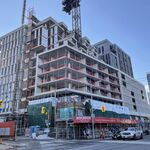Electrify
Senior Member
This was my comment to that article:
I'd like to be the devil's advocate for a minute and defend somewhat tighter stop spacing. Think of transit as an elevator: You're on the 7th floor and decide to walk up to the 8th floor, and feel that having the elevator stop there is a waste. However, someone who is getting on at the ground floor may also want to get off at the 8th floor, so having a stop there isn't a waste.
I'm not trying to say that transit should stop at everyone's doorstop, but there is a case for having a more local oriented transit with SOMEWHAT frequent stops. However, if demand and density is having your transit vehicle stop every 100m with a large number of passengers boarding at each stop, then it makes sense to use a higher-order transit vehicle with wider stops.
This comment and its replies are very refreshing. Most Torontonians who support public transit believe in Condon's theory; that urban transit should focus solely on a local need and feature frequent stops, this includes light rail and metro lines. Any long distance travel should be serviced by the separate commuter transit services. The previous LRT "rapid transit" plan presented by the previous mayor of Toronto would have spent billions of dollars to have trams stop every 400m in low density areas. This would not have provided the improved mobility worthy of this investment. With that said, I do strongly disagree with the new mayor's position of simply killing the plan, and feel it would be much wiser to try and fix some of its shortcomings than to scrap it and start from square one.
Furthering on this, I also agree with what some have said regarding using transit to concentrate mobility within the city rather than expand it. With transit fares costing as much as $3 per ride, in some cases each way, why would one take a slow moving bus or streetcar for their local needs when they can simply walk or cycle to their destination?
I'd like to be the devil's advocate for a minute and defend somewhat tighter stop spacing. Think of transit as an elevator: You're on the 7th floor and decide to walk up to the 8th floor, and feel that having the elevator stop there is a waste. However, someone who is getting on at the ground floor may also want to get off at the 8th floor, so having a stop there isn't a waste.
I'm not trying to say that transit should stop at everyone's doorstop, but there is a case for having a more local oriented transit with SOMEWHAT frequent stops. However, if demand and density is having your transit vehicle stop every 100m with a large number of passengers boarding at each stop, then it makes sense to use a higher-order transit vehicle with wider stops.
This comment and its replies are very refreshing. Most Torontonians who support public transit believe in Condon's theory; that urban transit should focus solely on a local need and feature frequent stops, this includes light rail and metro lines. Any long distance travel should be serviced by the separate commuter transit services. The previous LRT "rapid transit" plan presented by the previous mayor of Toronto would have spent billions of dollars to have trams stop every 400m in low density areas. This would not have provided the improved mobility worthy of this investment. With that said, I do strongly disagree with the new mayor's position of simply killing the plan, and feel it would be much wiser to try and fix some of its shortcomings than to scrap it and start from square one.
Furthering on this, I also agree with what some have said regarding using transit to concentrate mobility within the city rather than expand it. With transit fares costing as much as $3 per ride, in some cases each way, why would one take a slow moving bus or streetcar for their local needs when they can simply walk or cycle to their destination?




